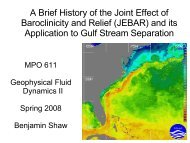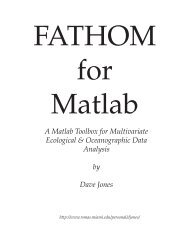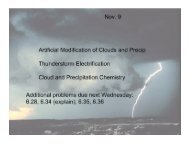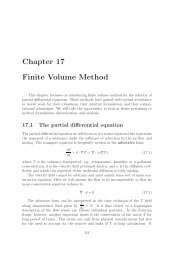2007 (PDF) - Rosenstiel School of Marine and Atmospheric Science ...
2007 (PDF) - Rosenstiel School of Marine and Atmospheric Science ...
2007 (PDF) - Rosenstiel School of Marine and Atmospheric Science ...
Create successful ePaper yourself
Turn your PDF publications into a flip-book with our unique Google optimized e-Paper software.
Tools & Technology<br />
Net Technology Gains<br />
The results are, in a word, stunning.<br />
Shedding New Light<br />
Biological oceanographers constantly struggle to reduce delays<br />
between specimen collection, data sorting, <strong>and</strong> final analysis.<br />
Traditionally biological measurements are made primarily by use<br />
<strong>of</strong> net collections, versus high speed digital output. Though net<br />
technology has become quite sophisticated, enabling vertical resolution<br />
coupled with detailed physical data, net samples still require<br />
manual processing, which is time-consuming <strong>and</strong> costly. For many<br />
projects, months to years <strong>of</strong> work must be spent sorting through<br />
samples before even beginning analysis.<br />
Top: ISIIS being hoisted into the water<br />
by a crane aboard the R/V F.G. Walton<br />
Smith to collect images <strong>of</strong> zoolpankton<br />
in the Caribbean Sea. Included in the<br />
samples gathered are (bottom left) salp<br />
chain <strong>and</strong> (bottom right) bothidae.<br />
Photo credit: Cedric Guig<strong>and</strong><br />
Dr. Robert Cowen <strong>and</strong> Cedric<br />
Guig<strong>and</strong> are developing a<br />
potential solution to this<br />
problem. With the help <strong>of</strong><br />
Bellamare, LLC, they designed<br />
<strong>and</strong> field-tested an experimental<br />
towed vehicle with the<br />
capabilities for non-invasive, in<br />
situ sampling <strong>of</strong> both zooplankton<br />
<strong>and</strong> associated water<br />
conditions.<br />
The In Situ Ichthyoplankton<br />
Imaging System (ISIIS) is<br />
composed <strong>of</strong> two large pressure<br />
vessels with a payload capacity<br />
sufficient for housing a highresolution<br />
plankton imaging<br />
system <strong>and</strong> its supporting<br />
hardware. ISIIS combines digital<br />
line scan cameras <strong>and</strong> high<br />
speed computer data transfer<br />
<strong>and</strong> storage devices with<br />
shadow photographic lighting<br />
techniques to record images<br />
at 68 micron pixel resolution<br />
with up to 20 cm depth <strong>of</strong><br />
field <strong>and</strong> 14 cm field <strong>of</strong> view.<br />
ISIIS is also equipped with various environmental sensors including<br />
a conductivity-temperature-depth (CTD) pr<strong>of</strong>iler, flourometer, <strong>and</strong><br />
others that allow it to map fine scale taxon-specific distributions in<br />
relation to ocean environmental conditions. The next generation <strong>of</strong><br />
ISIIS will incorporate undulating capabilities <strong>and</strong> integrated image<br />
analysis s<strong>of</strong>tware that can classify specimens based on shape <strong>and</strong><br />
textural characteristics. The result <strong>of</strong> all this high-tech machinery: a<br />
revolutionary increase in the speed <strong>of</strong> biological oceanography.<br />
Extreme Buoy Design<br />
In <strong>2007</strong>, scientists at the <strong>Rosenstiel</strong> <strong>School</strong> participated in several<br />
buoy deployments around the world. They also tested a new<br />
high-tech observational buoy<br />
designed to provide measurements<br />
<strong>and</strong> information<br />
about hurricane intensity in<br />
extreme wind conditions.<br />
Deployed in ‘Hurricane<br />
Alley” near Jacksonville,<br />
Florida, this buoy was designed<br />
to furnish information<br />
about air <strong>and</strong> sea interactions<br />
in extreme wind conditions,<br />
illuminating what we know<br />
about hurricane intensity,<br />
<strong>and</strong> helping to inform predictions<br />
in the future.<br />
The buoy was based on a<br />
hull designed by the U.S.<br />
Navy <strong>and</strong> utilized NOAA’s<br />
National Data Buoy Center<br />
for meteorological measurements<br />
in high wind <strong>and</strong><br />
Dr. Will Drennan prepares an Air-Sea<br />
Interaction Spar (ASIS) buoy for deployment<br />
during the <strong>2007</strong> Deep Ocean Gas Exchange<br />
Experiment <strong>of</strong>f the coast <strong>of</strong> Engl<strong>and</strong>. Photo<br />
credit: Hien Nguyen<br />
wave environments. To measure heat transfer rates in high winds,<br />
<strong>Rosenstiel</strong> <strong>School</strong> scientists Drs. William Drennan <strong>and</strong> Neil Williams<br />
redesigned everything above the waterline incorporating<br />
the latest sensors, several with special modifications to survive the<br />
Dr. Neil Williams prepares the Extreme Air-Sea Interaction (EASI) buoy for its<br />
maiden deployment in August <strong>2007</strong>, east <strong>of</strong> Jacksonville, Florida. Based on the NO-<br />
MAD hull used by the National Data Buoy Center, the buoy includes instrumentation<br />
<strong>and</strong> electronics tailored to measure parameters such as high wind speed drag coefficients,<br />
which can greatly enhance the ability <strong>of</strong> hurricane models to more accurately<br />
predict the intensity <strong>of</strong> storms. Photo credit: Mel Wang<br />
extreme conditions. The electronics within the buoy hull were outfitted<br />
with a unique data acquisition system developed in collaboration<br />
with Environment Canada.<br />
Researchers were aiming to garner the first-ever near-surface<br />
measurements <strong>of</strong> the heat transfer rates that allow hurricanes the<br />
necessary fuel they need to intensify. During times <strong>of</strong> high winds,<br />
increased sea-spray concentrations can be found in the layer <strong>of</strong><br />
atmosphere directly above the ocean. This layer has been thought to<br />
significantly affect evaporation rates <strong>and</strong> cyclone development, but,<br />
without significant data, scientists are still unsure. Indeed, the effect<br />
<strong>of</strong> sea spray on storm intensity remains one <strong>of</strong> the key unanswered<br />
questions in hurricane science.<br />
The buoy project was supported with funding from the National<br />
<strong>Science</strong> Foundation’s Ocean Technology <strong>and</strong> Interdisciplinary<br />
Coordination program. While the successful <strong>2007</strong> ‘shake down’<br />
test was focused on uses for this platform in hurricane applications,<br />
the team already has plans to use it for research in a variety <strong>of</strong> other<br />
high sea-state conditions, including typhoons.<br />
When Dr. David L. Jones, a fisheries<br />
oceanographer at the Cooperative Institute<br />
for <strong>Marine</strong> <strong>and</strong> <strong>Atmospheric</strong> Studies (CI-<br />
MAS) set out to design a better light trap<br />
to collect young reef fishes, he never imagined<br />
his invention would contribute to the<br />
discovery <strong>of</strong> a new species. But, after finding<br />
a larval goby that didn’t quite match<br />
any known description, his catch turned<br />
out to be the answer to another scientist’s<br />
25 year old research conundrum.<br />
Jones, working with scientists from El<br />
Colegio de la Frontera Sur (ECOSUR), deployed his new light<br />
traps in the deep tropical waters surrounding Banco Chinchorro,<br />
a remote coral reef atoll <strong>of</strong>f Mexico’s Costa Maya. The traps attracted<br />
the fish using a programmable lighting system enclosed in a<br />
submersible housing. It allowed the team to collect live specimens<br />
from a diverse range <strong>of</strong> reef fish species, which they meticulously<br />
sorted <strong>and</strong> identified every night.<br />
During his collection <strong>of</strong> fishes, Jones came across one specimen that<br />
differed slightly from the known species <strong>of</strong> Atlantic gobies by having<br />
fewer fin rays <strong>and</strong> lacking a frenum -- the small fold <strong>of</strong> tissue in<br />
the pelvic fins <strong>of</strong> most gobies that forms a sucking disc for grasping<br />
the substrate. He sent the fish to Dr. Benjamin Victor <strong>of</strong> the Ocean<br />
<strong>Science</strong> Foundation in California, who used a new biochemical<br />
technique known as barcoding to match mitochondrial DNA from<br />
the larva to an adult fish Victor himself had found near Panama,<br />
25 years earlier. Testing confirmed that<br />
the fish was a new species, genetically<br />
different from its closest know relatives<br />
by about 25%. Dubbed Coryphopterus<br />
kuna, the new goby marked the discovery<br />
<strong>of</strong> the first vertebrate to have its<br />
genetic barcode included in its original<br />
species description, published by Victor<br />
in the July <strong>2007</strong> issue <strong>of</strong> Zootaxa.<br />
Scientist Monica Lara uses<br />
the new light trap in the<br />
Caribbean Sea. Photo credit:<br />
Keri Wilk/ReefNet<br />
Coryphopterus kuna. Photo credit:<br />
Keri Wilk/ReefNet<br />
Research Resources<br />
The ISIIS <strong>and</strong> other equipment is <strong>of</strong>ten used aboard the R/V F.G. Walton Smith,<br />
the <strong>Rosenstiel</strong> <strong>School</strong>’s primary research vessel. This state-<strong>of</strong>-the-art, 96-foot<br />
research catamaran was placed into service in February 2000. Named in honor<br />
<strong>of</strong> the <strong>Rosenstiel</strong> <strong>School</strong>’s founder, the ship <strong>of</strong>fers 800 square-feet <strong>of</strong> laboratory<br />
space, as well as an additional 800 square feet <strong>of</strong> multi-use space astern. It is<br />
operated as part <strong>of</strong> the University National Laboratory System (UNOLS) fleet.<br />
In <strong>2007</strong>, the Walton Smith was at sea a total <strong>of</strong> 154 days, <strong>and</strong> conducted 31<br />
scientific cruises, <strong>of</strong> which more than a dozen had University <strong>of</strong> Miami faculty<br />
as principal investigators. Funding for voyages came from the National <strong>Science</strong><br />
Foundation, Office <strong>of</strong> Naval Research <strong>and</strong> the National Oceanic <strong>and</strong> <strong>Atmospheric</strong><br />
Administration, as well as, private companies, organizations.<br />
The R/V F.G. Walton Smith docked at the <strong>Rosenstiel</strong> <strong>School</strong><br />
on Virginia Key, Florida. Photo credit: UM/RSMAS<br />
Advanced Bookkeeping<br />
The year <strong>2007</strong> marked the addition <strong>of</strong> the venerable Zoological Record an e-format to the<br />
University <strong>of</strong> Miami’s library collection. First published in 1864, this resource is the world’s<br />
leading taxonomic reference database <strong>and</strong> the oldest continuing resource for animal biology<br />
research. Many publications by <strong>Rosenstiel</strong> researchers have been listed in this publication,<br />
including a 1945 article published in <strong>Science</strong>, written by F. G. Walton Smith. His article records<br />
one <strong>of</strong> the first reports <strong>of</strong> Coeloplana (comb jellies) living along the shorelines <strong>of</strong> the American<br />
continent. The discovery came to his attention after a student, William Sutcliffe, noticed the<br />
organisms crawling over the surface <strong>of</strong> algae <strong>and</strong> hydroids grown in tanks supplied by the lab’s<br />
sea water supply.<br />
The <strong>Rosenstiel</strong> <strong>School</strong> Library <strong>of</strong>fers one <strong>of</strong> the most extensive marine science literature collections<br />
in the nation. It continues to broaden its resources <strong>and</strong> exp<strong>and</strong> the availability <strong>of</strong> e-publications,<br />
increasing the array <strong>of</strong> subject matters available to faculty members <strong>and</strong> students -- regardless <strong>of</strong><br />
where their research takes them.<br />
7 8<br />
Graduate students Dwight Ebanks <strong>and</strong><br />
Marcela Ulate tap into the <strong>School</strong>’s resources<br />
using wireless technology. Photo<br />
credit: Oana Ioncel




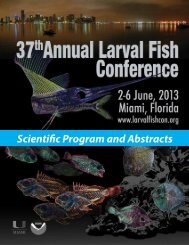
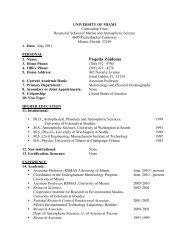
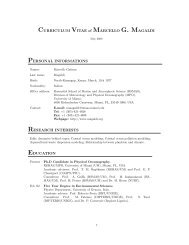
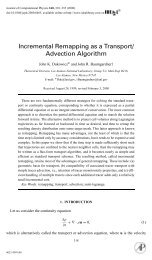
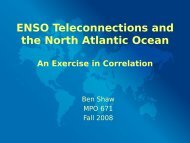
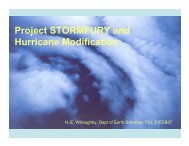
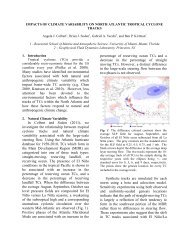

![Wavelength [μm] ZENITH ATMOSPHERIC TRANSMITTANCE](https://img.yumpu.com/26864082/1/190x143/wavelength-i-1-4-m-zenith-atmospheric-transmittance.jpg?quality=85)
